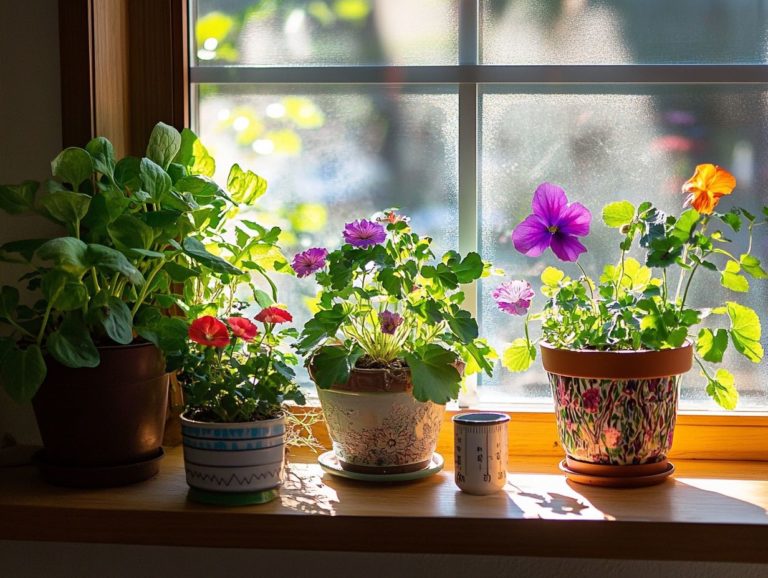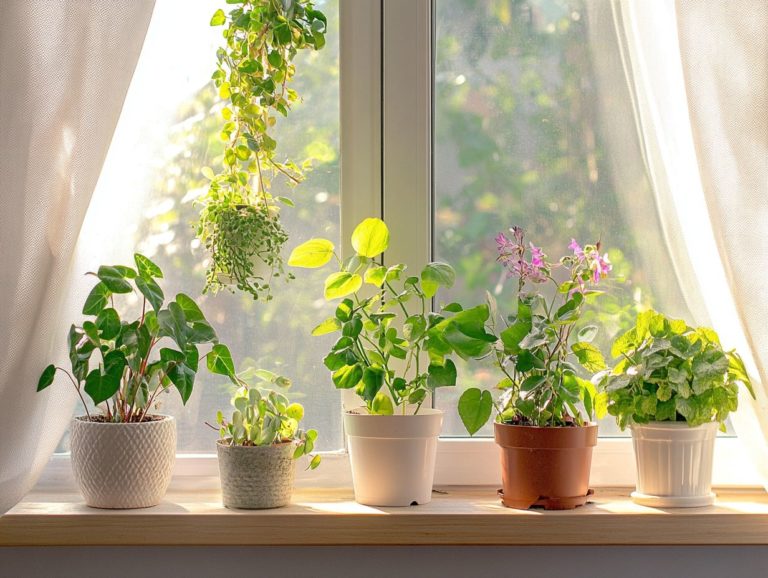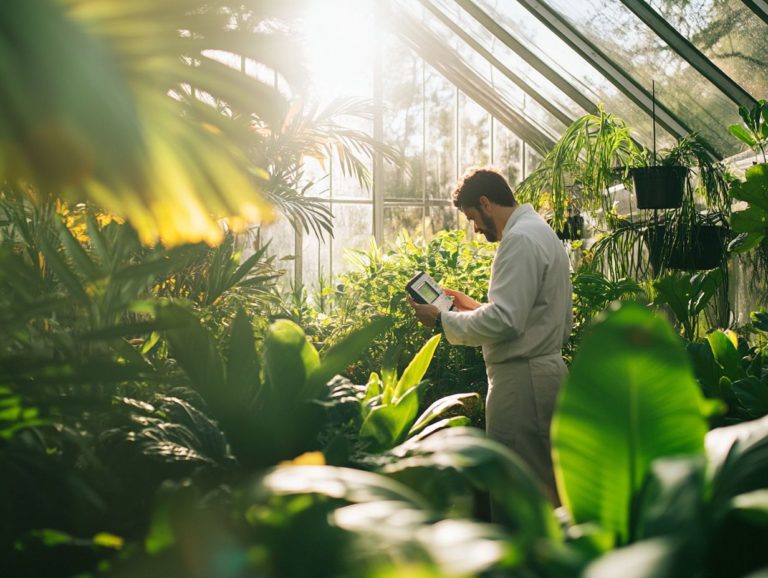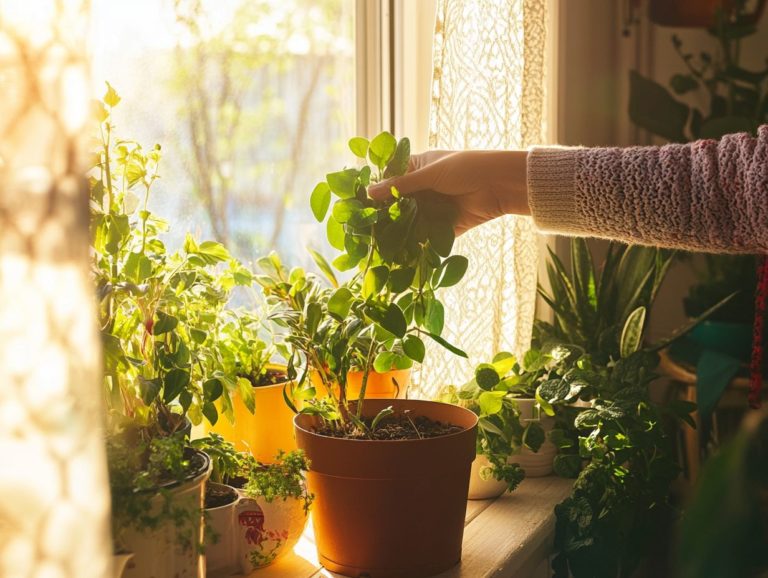Best Indoor Plants for West-Facing Windows
Transforming your space with lush greenery is a truly rewarding endeavor, especially if you have a west-facing window. These sunny spots offer abundant afternoon light, creating an ideal environment for a variety of indoor plants. Don t wait! Create your indoor paradise today!
Consider exploring the best options that thrive in such conditions, from the resilient Snake Plant to the striking Fiddle Leaf Fig. You ll also discover essential care tips that will help your plants flourish in their sunny nook.
Get ready to transform your space into a vibrant oasis! Uncover the perfect companions for your west-facing windows and watch your indoor oasis come to life.
Contents
- Key Takeaways:
- 1. Snake Plant
- 2. Aloe Vera
- 3. Spider Plant
- 4. Peace Lily
- 5. Dracaena
- 6. Pothos
- 7. ZZ Plant
- 8. Rubber Plant
- 9. Philodendron
- 10. Chinese Evergreen
- 11. Monstera
- 12. English Ivy
- 13. Fiddle Leaf Fig
- 14. Bird of Paradise
- 15. Cacti or Succulents
- How to Care for Indoor Plants in West-Facing Windows?
- Frequently Asked Questions
Key Takeaways:
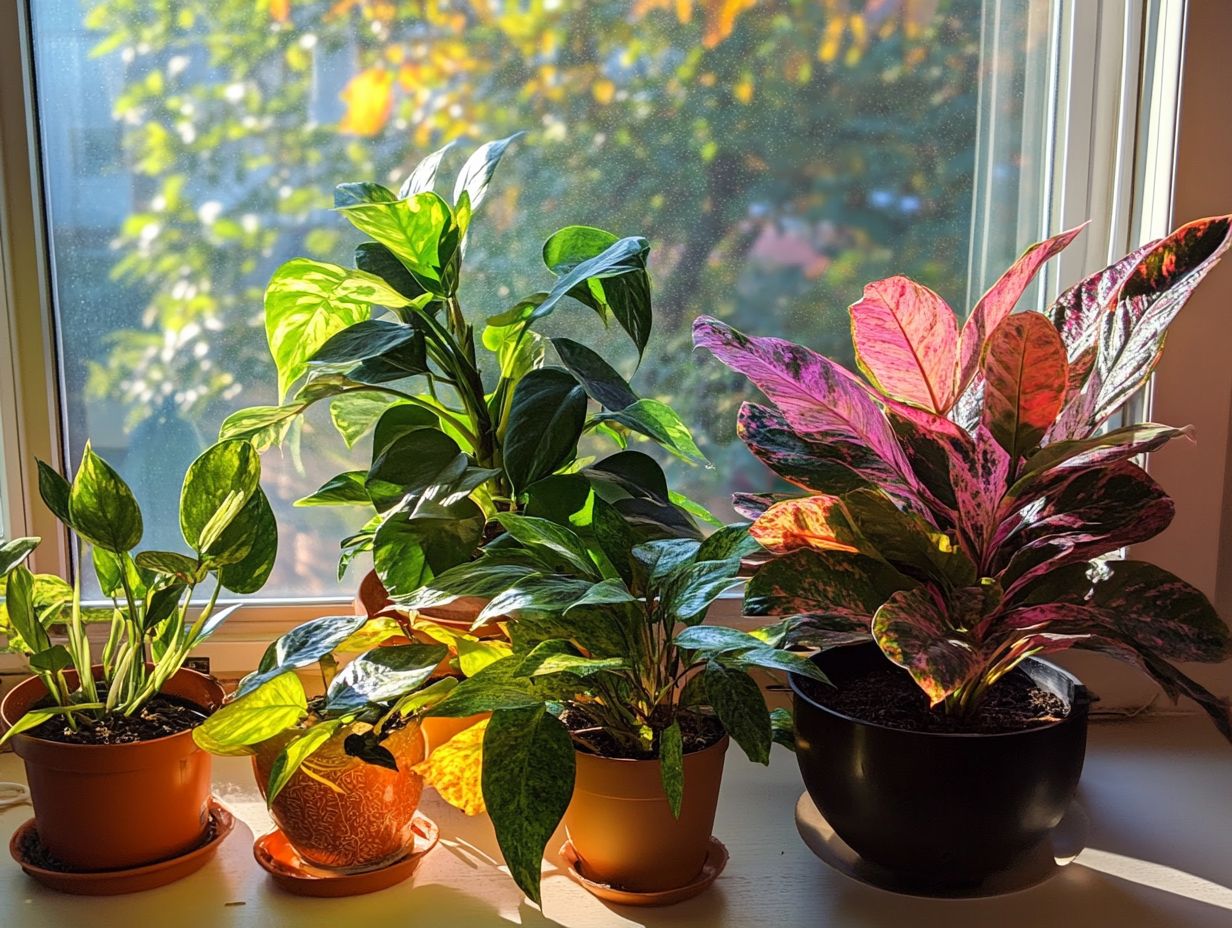
- Choose low-maintenance plants that are perfect for beginners, like Snake Plant, Spider Plant, ZZ Plant, Yucca, and Kalanchoe, for west-facing windows.
- Avoid direct sunlight and provide consistent moisture for succulents and cacti in west-facing windows.
- Consider using English Ivy, Philodendron, or Peace Lily for their ability to purify the air in your home.
1. Snake Plant
The Snake Plant, or Sansevieria, is the ultimate resilient houseplant. It thrives in a range of light conditions that cater to both novice and seasoned indoor gardeners. Its remarkable ability to adapt to indirect sunlight means it can flourish in diverse environments.
This plant effortlessly adds an air of elegance to your indoor space. Beyond its visual appeal, it also improves air quality, making it a must-have for your home.
For the best growth, it prefers temperatures between 60 F and 80 F just like its tropical origins. To keep those striking, sword-like leaves looking their best, dust them regularly for that extra glossy shine.
If you want to expand your collection, you can easily grow new plants by cutting off a leaf and placing it in soil or water. With its low maintenance demands, the Snake Plant is a favorite for anyone who might not consider themselves a green thumb.
It not only purifies the air, creating a healthier living environment, but also serves as a stunning centerpiece that elevates your space with its unique leaf care.
2. Aloe Vera
Aloe Vera is a sought-after succulent celebrated for its remarkable healing properties and straightforward care, making it a top choice among indoor gardening enthusiasts.
To cultivate it successfully, you ll want to provide bright light and well-drained soil. Understanding its growing requirements is key to ensuring the best health for the plant.
This resilient plant easily adapts to various humidity levels, allowing it to flourish indoors while adding both aesthetic appeal and practical benefits.
With its impressive ability to thrive in dry air, Aloe Vera is particularly well-suited for homes, especially in regions where humidity tends to dip. For the best results, position it near a sunny window, but steer clear of direct, harsh sunlight that could scorch its leaves.
The ideal soil is a cactus mix that enhances drainage, helping to prevent root rot. Propagation is simple; whether you opt for offsets or leaf cuttings, it’s easy to expand your collection.
By having Aloe Vera at home, you gain easy access to its soothing gel, perfect for alleviating burns and skin irritations offering a natural remedy right at your fingertips.
3. Spider Plant
The Spider Plant stands out as a versatile indoor gem. It is celebrated for its ability to clean the air and delightful appearance, making it a beloved addition to countless homes. Thriving in moderate to bright indirect light, it adapts beautifully to varying humidity levels. This ensures a vigorous growth cycle.
With its long, hanging leaves and distinctive spider-like offshoots, this plant not only elevates your space aesthetically but also contributes to a healthier indoor atmosphere.
Caring for this resilient beauty involves providing it with ample light while steering clear of direct sunlight, which can scorch its leaves. It flourishes in the typical humidity levels found in most homes; however, a bit of occasional misting can work wonders for its development. Regular watering is crucial. Letting the soil dry out slightly between waterings will promote optimal growth.
You can easily make new plants from existing ones by separating its offshoots and replanting them. The Spider Plant doesn t just purify the air by removing toxins; it can lift your spirits and brighten your day! Bring one of these beautiful plants home today!
4. Peace Lily
The Peace Lily, with its elegant white blooms and glossy green leaves, is a captivating addition to any indoor space. It’s not just admired for its beauty; it also boasts impressive air-purifying capabilities. Thriving in low to moderate indirect sunlight, this plant demands care regarding humidity and watering. Ensuring it grows healthily and blooms beautifully throughout its season requires attention.
To keep your Peace Lily content, aim for a humidity level of around 50-60%, which mirrors its natural tropical habitat. Regularly misting the leaves or placing a humidifier nearby can create an ideal environment for plant care and growth.
Regarding watering, remember to let the top inch of soil dry out between waterings. Overwatering can lead to root rot, which is detrimental. It s advisable to use room temperature, distilled, or rainwater to sidestep any chemicals often found in tap water.
Wiping the leaves with a damp cloth not only keeps them dust-free but also promotes healthier photosynthesis, which is the process plants use to turn sunlight into food. This enhances the plant’s vibrancy and blooming potential.
5. Dracaena
Dracaena is a captivating genus of indoor plants that presents a variety of species, each showcasing unique foliage and growth habits. This makes it a favored choice among home decorators. These plants prefer bright, indirect light but can adjust to lower light conditions. However, they truly flourish when afforded adequate light exposure and humidity.
Take Dracaena marginata, for example. It thrives in bright, indirect light and can handle lower humidity levels. Meanwhile, Dracaena fragrans revels in higher humidity and is perfectly content in shadier spots. Regular misting or using a humidity tray can work wonders for those varieties that prefer a more humid environment.
You can also expand your collection or share the joy with friends by taking cuttings from healthy stems and rooting them in water or soil. Keep a close eye on water levels and ensure proper drainage to avoid root rot. This will allow these stunning plants to remain vibrant and lush throughout the seasons. Bring a Dracaena home today!
6. Pothos
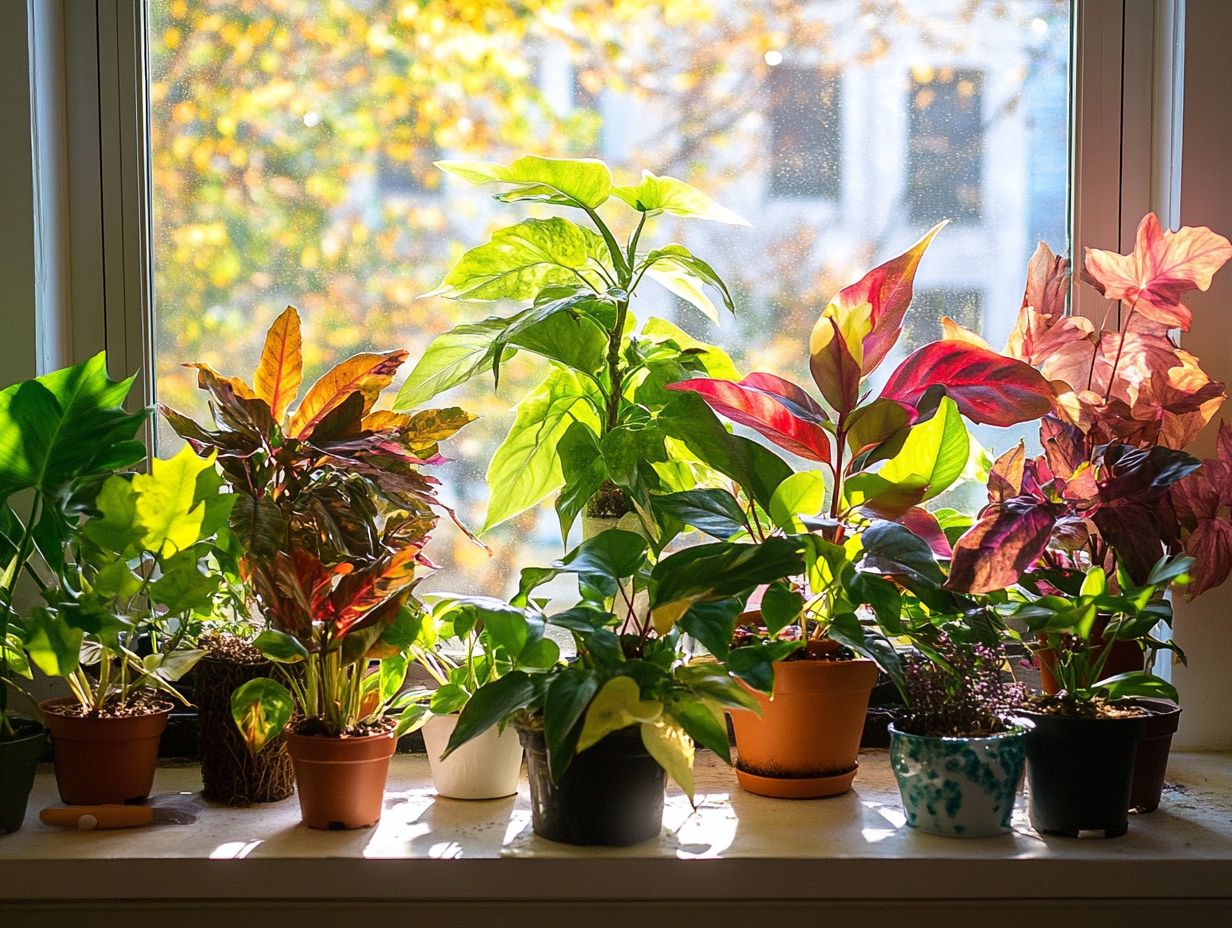
Pothos, often referred to as Devil’s Ivy, is an exceptionally adaptable indoor plant that you ll appreciate for its trailing vines and heart-shaped leaves. This resilient beauty flourishes in a variety of light conditions whether in low light or bright, indirect sunlight while easily adjusting to different humidity levels.
When given the right care, your Pothos can grow vigorously, infusing any room with vibrant greenery.
To ensure your Pothos thrives, avoid placing it in direct sunlight, as that can scorch its stunning leaves. A location with bright, indirect light is ideal for promoting its growth.
This plant is quite forgiving regarding humidity, but it truly flourishes in moderate humidity. Consider misting it occasionally or positioning it near a humidifier during those dry months for optimal health.
One of the standout features of this plant is its remarkable ability to grow a new plant from a cutting. Simply cut a stem and place it in water until roots develop, and voil you have a new plant!
Pothos isn t merely an aesthetic enhancement for your home; it s also a fantastic air purifier by filtering out toxins, making it a valuable companion in your indoor space.
7. ZZ Plant
The ZZ Plant is an exceptional choice for your indoor gardening endeavors, celebrated for its glossy leaves and impressive ability to thrive in low-light conditions. With minimal care requirements, this plant can easily adapt to a range of humidity levels, making it perfect for beginners and those with a busy lifestyle.
By understanding its growing needs, you can enjoy its beauty without the stress of demanding upkeep. This resilient plant prefers indirect light, making it an ideal companion for dimly lit rooms where other plants might falter.
Regarding watering, remember that less is often more; allowing the soil to dry out completely between waterings promotes healthy growth and helps prevent root rot.
Maintenance is a breeze simply wipe its leaves periodically to remove dust and keep them gleaming.
With such low maintenance and adaptability, the ZZ Plant effortlessly adds elegance and ease to any indoor plant collection, rewarding those who care for it with its understated beauty.
8. Rubber Plant
The Rubber Plant, with its large, glossy leaves, is the perfect indoor companion that not only elevates the aesthetic of any room but also enhances air quality. This beauty thrives in bright, indirect light and enjoys a touch of humidity, all while being relatively low-maintenance.
With a little attention, you ll see your Rubber Plant grow to impressive heights, becoming a stunning focal point in your space.
To ensure it flourishes, position your Rubber Plant near a window that filters harsh sunlight too much direct exposure can scorch those gorgeous leaves. Aim to keep humidity levels between 40-60% for optimal growth.
If the air in your home is dry, consider using a humidifier or placing a pebble tray filled with water beneath the pot to provide extra moisture.
Keep an eye out for pests like spider mites and aphids; they can be tackled with insecticidal soap, a product that helps get rid of pests. A little regular pruning goes a long way, promoting bushier growth and helping to maintain the overall health of your plant.
9. Philodendron
Philodendrons are the darlings of indoor gardening, cherished for their breathtaking foliage and effortless care, making them a top pick for plant aficionados like you.
These tropical beauties thrive in bright, indirect light, relishing an environment where they re protected from harsh rays that could scorch their stunning leaves. They flourish in humidity levels between 60% and 80%, so using a pebble tray or misting them regularly will help keep that ideal moisture balance.
A well-draining potting mix, rich in organic matter, is essential for giving their roots the air circulation they desire.
For propagation, enthusiasts often opt for stem cuttings or division both methods foster healthy growth and robust root systems. Regular pruning is also smart, as it not only encourages bushier growth but also helps eliminate any yellowing leaves, keeping your philodendron vibrant and thriving.
10. Chinese Evergreen
Chinese Evergreens are beloved indoor plants known for their striking leaves and easy care. They fit perfectly in homes, whether you’re an experienced gardener or just starting out.
They thrive in low to moderate light and adapt to different humidity levels. This means you can enjoy their beauty with little effort.
To maintain their vibrant colors, create a balanced environment with moderate humidity ideally between 40-60%. A simple trick is to mist the leaves regularly or place a humidity tray nearby to help sustain this level.
Be cautious about overwatering. Allow the top inch of soil to dry out between watering sessions to support healthy growth.
If you want to propagate, division is your best bet. Just ensure that each new section has both roots and adequate foliage.
Keep an eye out for common pests like spider mites or scale. Act quickly to address any signs of distress to ensure these stunning plants continue to thrive in your home.
11. Monstera
Monstera, often called the Swiss Cheese Plant, is a standout in indoor gardening. Its unique leaves and bold presence brighten any room.
This tropical beauty thrives in bright, indirect light. It also needs a bit of humidity to keep those iconic split leaves healthy.
Aim for humidity around 60-80%, mimicking its natural habitat. Regular misting or using a humidifier can work wonders, especially in drier climates.
As your Monstera grows, it may sprawl and reach impressive heights, so providing a support system, such as a moss pole, is a wise move.
Propagating is easy simply take a cutting with at least one small part of the stem where leaves grow and place it in water until roots develop. Once those roots are ready, transfer it to soil for a new plant that can flourish alongside its parent.
12. English Ivy
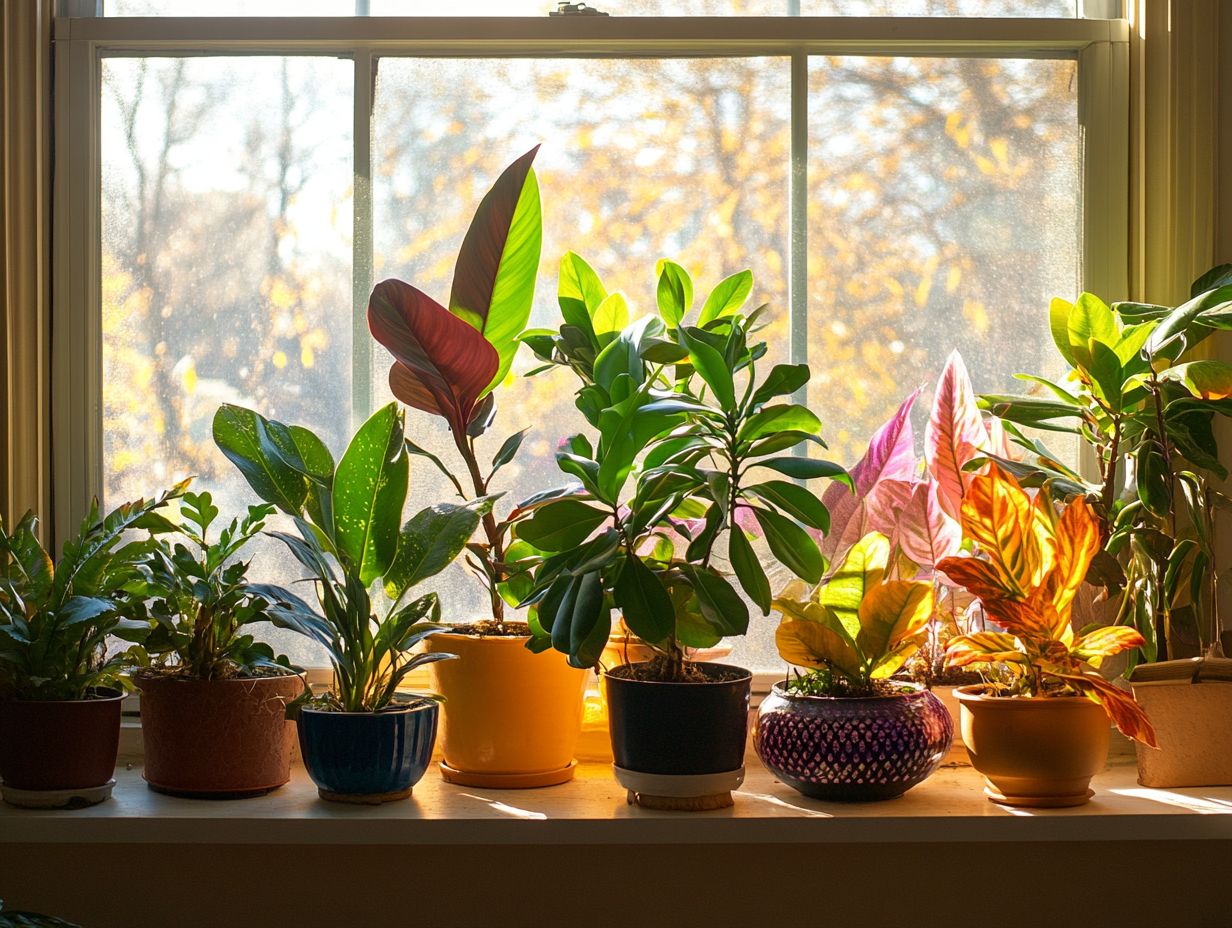
English Ivy is a timeless indoor plant that showcases trailing vines and lush green leaves, transforming the aesthetic of any space. It thrives in moderate to bright indirect light and prefers consistent humidity.
To ensure optimal growth, maintain humidity levels between 40% and 60%. Regular misting or using a humidifier can work wonders, especially during drier months.
Water it only when the top inch of soil feels dry. Avoid soggy conditions that could lead to root rot, as this resilient plant can grow vigorously.
For propagation, simply take cuttings and place them in water or soil to encourage new root development. With these tips, you’ll cultivate stunning, vibrant vines that bring a touch of nature to your indoor garden.
13. Fiddle Leaf Fig
The Fiddle Leaf Fig is a stunning indoor plant, instantly recognizable with its large, violin-shaped leaves. It s no wonder decorators are drawn to it as a bold statement piece.
This beauty prefers bright, indirect light and requires a bit of finesse with humidity levels to truly shine. Familiarizing yourself with its needs will help you enjoy a vibrant Fiddle Leaf Fig that elevates your living space.
Position your plant near a window, but keep it away from direct sunlight; harsh rays can scorch those gorgeous leaves. Aim for humidity levels between 30-65%, which you can achieve by misting the leaves, using a pebble tray, or placing a humidifier nearby.
Regularly check for pests and monitor for signs of overcrowding. Issues like leaf drop or brown edges often arise from insufficient moisture or erratic watering.
Stay attentive, and you ll encourage healthy growth, allowing this stunning plant to flourish as an eye-catching centerpiece in your home.
14. Bird of Paradise
The Bird of Paradise is an extraordinary indoor plant that captivates with its vibrant foliage and striking appearance. It effortlessly infuses a touch of tropical elegance into your space. This beauty prefers bright light and humidity levels that mirror its natural habitat. Understanding its growing requirements enables you to keep your Bird of Paradise as the showstopper it was meant to be.
To create a home similar to its natural environment, place it in a location where it can soak up bright, indirect sunlight for at least six hours a day. Consistent humidity around 50-60% is crucial. Consider misting the leaves regularly or positioning the pot on a pebble tray filled with water for added moisture.
Water generously during the active growing season, but be cautious not to let the roots sit in water, as this can lead to root rot.
Watch for challenges like leaf discoloration or drooping, which can indicate insufficient light or humidity. By keeping these conditions just right, you’ll enjoy the magnificent beauty of your Bird of Paradise.
15. Cacti or Succulents
Cacti and succulents have become the go-to choices for indoor gardeners. Their stunning variety and minimal maintenance demands make them ideal for those with busy lifestyles. These resilient plants thrive in bright light and well-drained soil. They require little humidity to flourish, making them perfectly suited for indoor settings. By grasping their specific care needs, you can cultivate vibrant, healthy plants that truly elevate your living space.
With numerous varieties available, each plant exhibits unique characteristics that influence its care. For example, some cacti bask in direct sunlight, while others thrive quite well in partial shade. Succulents typically appreciate a harmonious blend of sun and shade, adding to their charm as adaptable companions.
Soil type is critical; a mix formulated for cacti often comprising sand or pumice ensures proper drainage and helps prevent root rot. Both cacti and succulents usually require watering only when the soil has completely dried out. This is key to avoiding common pitfalls like overwatering or pest invasions. By fine-tuning light exposure, soil composition, and moisture levels to suit each species, you can create an indoor oasis that truly flourishes.
How to Care for Indoor Plants in West-Facing Windows?
Caring for indoor plants in west-facing windows presents unique challenges and opportunities. These spots bask in intense afternoon sunlight, significantly influencing their growth and health. Understanding the light conditions and humidity levels in these spaces is crucial for ensuring your plants thrive. Different varieties have specific growing requirements that you must meet for optimal development.
Master the nuances of plant care in these environments to successfully cultivate a diverse range of indoor plants.
Selecting the right plants, such as succulents and flowering varieties, can make a significant difference. Succulents like jade and aloe love bright light but require careful watering to prevent root rot. Ensuring their pots have good drainage is essential.
For flowering plants, consider options like geraniums or hibiscus, which thrive in warmth and brightness. To maintain humidity levels, group your plants together to create a microclimate. Misting can help prevent leaf sunburn.
Regularly rotating your plants ensures they receive even light, preventing leggy growth and allowing these green companions to flourish splendidly.
Frequently Asked Questions
What are the best indoor plants for west-facing windows?
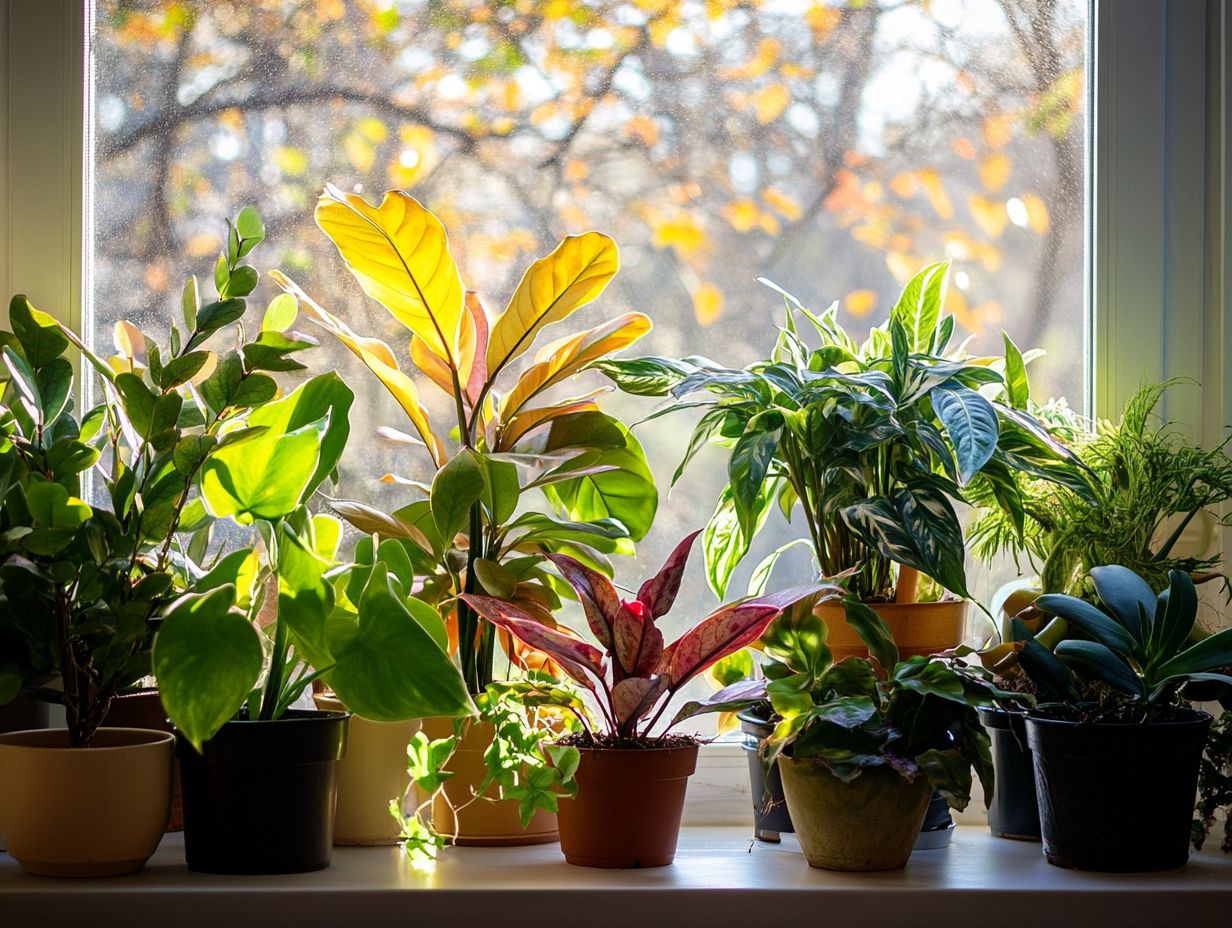
Some of the best indoor plants for west-facing windows include succulents, cacti, spider plants, snake plants, and philodendrons.
Why are these plants ideal for west-facing windows?
These plants thrive in bright, indirect light, typically found in west-facing windows. They also require minimal watering and maintenance, making them perfect for busy individuals.
Start your journey with indoor gardening today and watch your space transform!
What are the benefits of having indoor plants in west-facing windows?
Indoor plants add beauty to your home. They also clean the air and create a relaxing atmosphere.
These plants can help regulate temperature by providing shade and humidity.
Do these plants require any special care in west-facing windows?
These plants thrive in west-facing windows. You need to monitor their water and light needs.
Avoid direct sunlight, as it can burn the leaves. Rotate the plants every few weeks for even growth.
Can I mix and match different types of plants for my west-facing window?
Absolutely! Combining different plants creates a beautiful display.
Just choose plants with similar light and water needs to help them thrive together.
Are there any plants I should avoid placing in west-facing windows?
Avoid plants that need low light, like ferns and peace lilies, in west-facing windows. They prefer indirect light and might struggle in direct sunlight.


